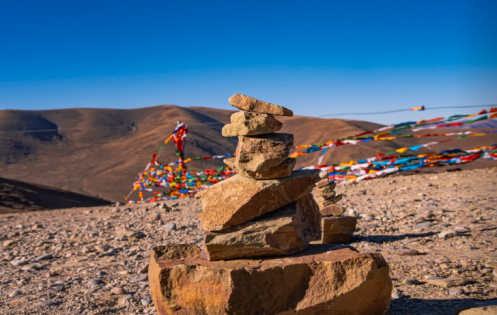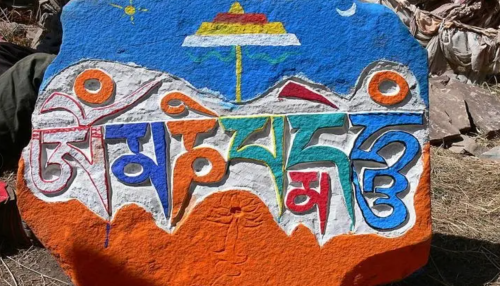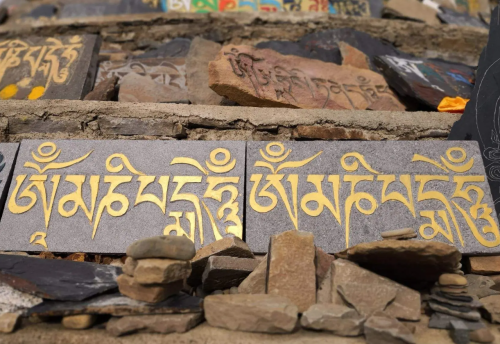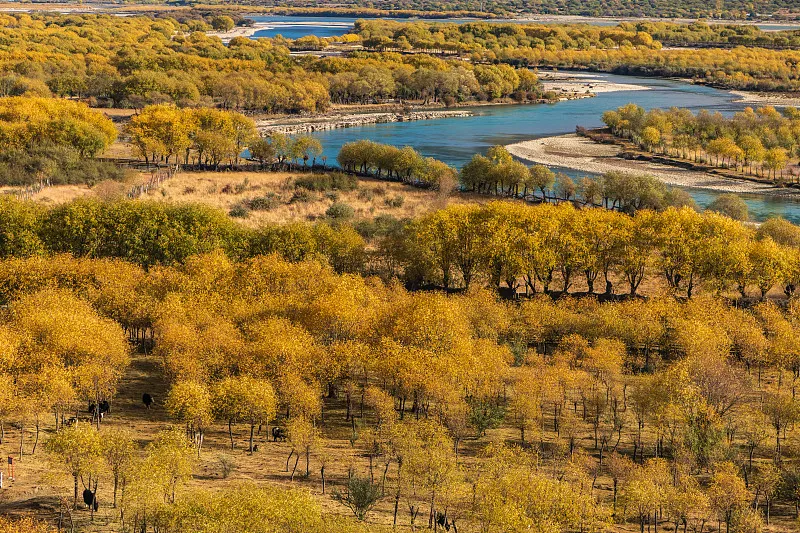Traveling through Tibet’s highland landscapes, one cannot miss the countless piles of stones inscribed with Buddhist prayers, stacked at mountain passes, riversides, and temples. These are Mani stones and Mani cairns (玛尼堆)—unique cultural symbols of Tibetan Buddhism. More than just physical monuments, they embody Tibetans’ deep spirituality, devotion, and relationship with nature.
Origins of Mani Stones
The tradition of carving prayers on stones dates back over a thousand years. The most common inscription is the six-syllable mantra, “Om Mani Padme Hum”, the essence of Avalokiteshvara’s compassion. By engraving this prayer onto rocks, Tibetans believe the mantra becomes eternal, blessing all who see, touch, or walk past.
Carving Mani stones is often done by artisans and lay devotees, who dedicate the act as a form of spiritual practice. Over time, river valleys, mountain trails, and monastery paths have become adorned with walls of inscribed stones, turning natural landscapes into living scriptures.
Mani Cairns: Sacred Stone Piles
A Mani cairn (玛尼堆) is formed when travelers place Mani stones one atop another, usually at significant places like:
-
Mountain passes: to honor protective deities and pray for safe journeys.
-
Crossroads: as offerings to local spirits and guardians.
-
Riversides and bridges: to purify and bless the flowing waters.
Each stone added to a cairn carries a personal prayer, gradually building a sacred monument of collective devotion. Some cairns grow into vast structures, stretching for hundreds of meters, such as those near Lhasa and Shigatse.

Symbolism and Spiritual Meaning
Mani stones and cairns are not random piles of rock; they are deeply symbolic:
-
Prayer in permanence: Unlike fleeting chants, carved stones preserve prayers for generations.
-
Interaction with nature: The act integrates human faith into the mountains, rivers, and winds.
-
Collective merit: Each added stone strengthens the spiritual power of the cairn, turning it into a community prayer site.
For Tibetans, walking clockwise around a Mani cairn, spinning prayer wheels, or simply touching the stones is believed to accumulate merit and cultivate compassion.
Mani Stones in Tibetan Daily Life
-
Pilgrims: On their journeys to holy sites like Mount Kailash, pilgrims carve or carry Mani stones to leave behind at sacred spots.
-
Festivals: During Losar (Tibetan New Year) or local rituals, families may add new stones to cairns as blessings for health and prosperity.
-
Art and Craft: Some Mani stones are simple carvings, while others are painted with vivid colors and intricate patterns, making them both spiritual objects and folk art.
Famous Sites to See Mani Cairns
-
Sera Monastery, Lhasa: Known for its prayer walls lined with thousands of stones.
-
Mount Kailash Kora: Pilgrims leave Mani stones around the sacred mountain during circumambulation.
-
Yarlung Valley: Considered the cradle of Tibetan civilization, filled with ancient cairns.
-
Lake Namtso and Yamdrok: Shores dotted with cairns, blending natural beauty with spiritual devotion.
Experiencing Mani Culture as a Traveler
Visitors to Tibet can respectfully engage with Mani cairns by:
-
Walking clockwise around cairns.
-
Adding a stone with reverence (but never removing one).
-
Observing how locals treat the sites with quiet devotion.
-
Learning about the meanings of mantras from local guides.
Travelers are encouraged to see Mani stones not as tourist attractions, but as living cultural heritage reflecting centuries of faith.
Conclusion
The Mani stones and cairns of Tibet are more than sacred carvings; they are a cultural dialogue between humans, faith, and the natural world. Every inscribed syllable and every piled rock represents a prayer for compassion, peace, and harmony. For travelers, encountering these stone scriptures offers a glimpse into the soul of Tibetan culture—a place where spirituality is etched into the very landscape.














